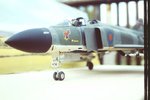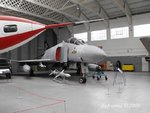Airframes
Benevolens Magister
Worst part was widening the intakes and making the deeper rear fuselage, as well as making the larger jet pipes. Unfortunately, the 1/32nd scale version got wrecked, but here's a couple of pics taken before it was finished, circa 1981 or '82. The eagle and roundels were hand-painted, as were the markings on the fin, and I think the serial numbers - my hands worked in those days !!



